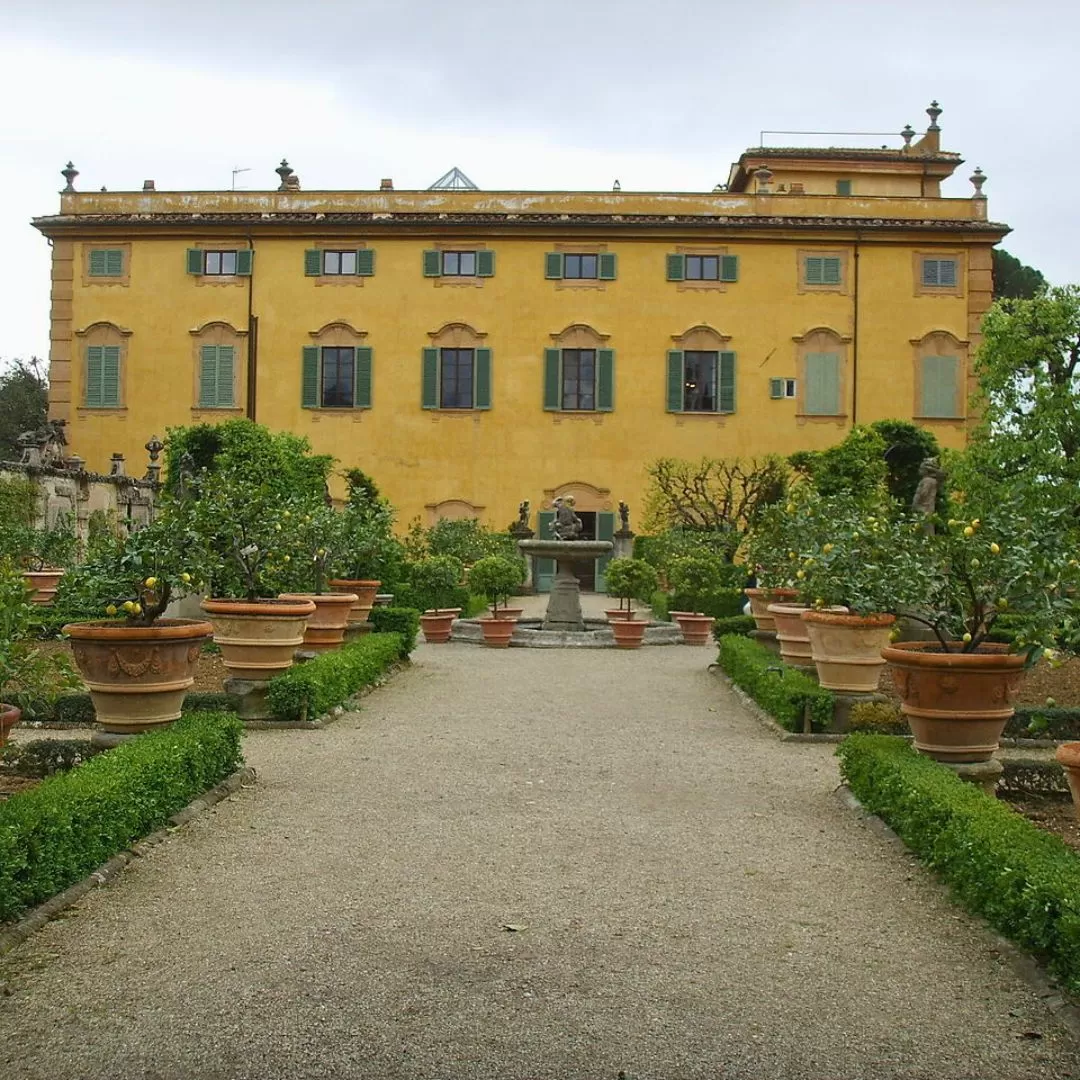Villa La Pietra
Villa La Pietra, hidden among the streets of Florence at number 120 via Bolognese, has been a precious jewel in the diadem of New York University since 1994. This splendid mansion, concealed behind an imposing iron gate embraced by statues and large vases, reveals itself to the visitor after a picturesque walk along an avenue lined with cypress trees. Its name is a tribute to the small locality on via Bolognese, named in reference to an ancient Roman milestone, a silent witness to the seventh mile from the north gate of ancient Florence. The history of Villa La Pietra takes root in the 14th century, when the lands and buildings were owned by the Macinghi. However, different sources attribute the origins of the villa to Michele Bruni in the 15th century, who donated his property to the consuls of the Arte della Lana. It then changed ownership in 1460, passing into the hands of the banker Francesco Sassetti (1), who renovated an existing building according to Renaissance elegance.
The history of Villa La Pietra takes root in the 14th century, when the lands and buildings were owned by the Macinghi. However, different sources attribute the origins of the villa to Michele Bruni in the 15th century, who donated his property to the consuls of the Arte della Lana. It then changed ownership in 1460, passing into the hands of the banker Francesco Sassetti (1), who renovated an existing building according to Renaissance elegance.
The villa knew many owners, including Giuliano di Piero Capponi (2) in 1546, whose family transformed it into a Baroque residence under the aegis of Cardinal Luigi Capponi (3). The latter, after a period in Romagna, returned to Florence to beautify Villa La Pietra, making it a residence of extraordinary magnificence, with a central elliptical environment and a dramatic staircase, while preserving some 15th-century elements such as ribbed vault ceilings.
At the beginning of the 19th century, the villa was the scene of historical events, hosting Ferdinand III of Tuscany. After the death of Gino Capponi (4), a writer and statesman, the villa passed to the Incontri and finally to the Actons in the 20th century.  Arthur and Hortence Acton (5) dedicated themselves to the renovation of the garden, opting for a classic Italian setting, enriching the park with numerous statues, many of which were the work of Federico Bonazza.
Arthur and Hortence Acton (5) dedicated themselves to the renovation of the garden, opting for a classic Italian setting, enriching the park with numerous statues, many of which were the work of Federico Bonazza.
Inherited by their son Harold (6), the villa became a significant cultural center, hosting an extraordinary collection of art. Among its illustrious guests was Charles of England. Upon Harold's death, the villa was bequeathed to New York University, which has undertaken an extensive restoration program. The villa's garden, a Baroque masterpiece, is divided into terraces with sculptures and architectural elements framing the splendid view of the Tuscan countryside. The Acton Collection, gathered during the golden age of collecting in Florence, includes paintings, tapestries, frescoes, sculptures, and various art objects, testifying to the elegance and aesthetic taste of the period.
Today, Villa La Pietra continues to be a place of culture and beauty.
(1) - Francesco Sassetti (1421-1490) was a Florentine banker of the Renaissance, known for his work with the Medici bank. His influence extended beyond the financial sphere, being a patron of the arts and an active member of Florence's cultural life. His legacy also includes the architectural transformation of properties and villas, including Villa La Pietra.
(2) - Giuliano di Piero Capponi (1476-1565) was a prominent member of the Capponi family, one of the noble families of Florence during the Renaissance. Although there are no precise birth and death dates, he is known for having purchased and then transformed Villa La Pietra in 1546, marking the beginning of a long connection between the villa and the Capponi family.
(3) - Cardinal Luigi Capponi (1583-1659) was a cardinal of the Catholic Church, remembered for his role as papal legate and his passion for architecture and art. During his stay at Villa La Pietra, he endeavored to transform it into a Baroque residence of exceptional beauty, making significant changes that influenced the current appearance of the villa.
(4) - Gino Capponi (1792-1876) was a great Italian writer, historian, and statesman, known for his involvement in the cultural and political life of 19th-century Italy.
(5) - Arthur Acton (1873-1953) and Hortense Mitchell Acton (N/A), an art collector and patron, and his wife Hortense Mitchell, were key figures in the history of Villa La Pietra in the 20th century.
(6) - Harold Acton (1904-1994), son of Arthur and Hortense, Harold Acton was a writer, dandy, and art collector who inherited Villa La Pietra. His life among the international cultural elite and his generosity in donating the villa to New York University marked the last private chapter of this place before it became a university campus.

Altri articoli

Michelangelo and portrait on the facade
What do you think? Do you believe Michelangelo have ever spent his time in a similar way?

Villa La Pietra
A historic villa becomes a university campus in '94. It has historical roots dating back to the 14th century, passing through the hands of bankers,

Do you know a secret passage?
In 1877 the secret passage was accessible: four thousands and five hundreds of people crossed it paying twenty-five cents each one!

A Mule is celebrated in the Palazzo Pitti
The marble decoration is situated on the left part of the courtyard.

